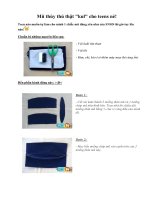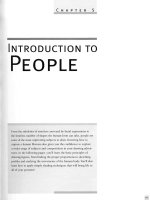Did You Trace That? Freehand Drawing and You! doc
Bạn đang xem bản rút gọn của tài liệu. Xem và tải ngay bản đầy đủ của tài liệu tại đây (85.98 KB, 4 trang )
Did You Trace That? Freehand
Drawing and You!
Often when you have really impressed someone, whether a friend or parent, you
will be asked, "Did you draw that freehand?" This may give you a great feeling
of accomplishment and pride in your work, but what exactly does freehand
drawing mean?
When most people think of freehand drawing, they think of drawing with just the
pencil and paper with no aids or stencils. This is correct; however, drawing
freehand can mean many things. It is great to be able to draw things just by
looking at them and transferring them with your eye and hand to the paper. There
are also many different ways to "draw freehand."
My definition of freehand drawing is drawing anything without directly
copying the entire image from start to finish using aids.
There are different levels of drawing
freehand. I'm not referring to using a compass or ruler, as these are tools that you
still have to use independently. I am referring to an aid that directly projects
images or that you use for tracing.
The most common aid would of course be a projector and sometimes a lightbox.
For example — for larger pieces where I have already created a composition and
printed it out for reference, I will transfer it to the paper using a projector. I will
not finish the entire project with the projector. I will just use it to rule out error on
proportions when transferring the design to a bigger mount.
To me this is freehand drawing
I will only outline and capture the main details of the piece, then finish the
project with the reference picture in front or right next to me for further
reference.
Tip: If you don't pay attention, relying on the projected image too much can also
result in a skewed image, as most projectors tend to bend the image at the edges
(the more affordable ones anyway, which are still in the 50 to 150 dollar range).
If you tell some people that you used a
projector and sketched the outline of the picture, they will say that you have
somehow "cheated." This could not be further from the truth.
It is one thing to completely trace and copy an image from start to finish with a
projector and call it your own. It is another thing to get the main concepts down
and finish the piece on your own without tracing everything from the projected
image.
Learning to use the drawing aids that are available to you effectively and relying
on them are the two main differences in drawing freehand and copying or
"cheating." With that being said, if you start to rely on the aid for everything, you
will be hampering your growth and ability to "see" what you are drawing. The
more you draw things without aids, the better you will get at drawing things
freehand.
The point here is to learn how and when to use the aids that you have
available to you effectively and to not rely on them extensively.
When transferring work to a bigger canvas or mount, a projector is a great tool. It
lets you focus on the actual elements of the piece without having to make sure the
proportions aren't off or if that line doesn't quite look right. So use your aids
wisely!
For more tips on drawing things freehand or getting the proportions correct, check
out my other article on Drawing Scale. It has lots of other tips on drawing things
freehand and making sure things turn out the way you want.









